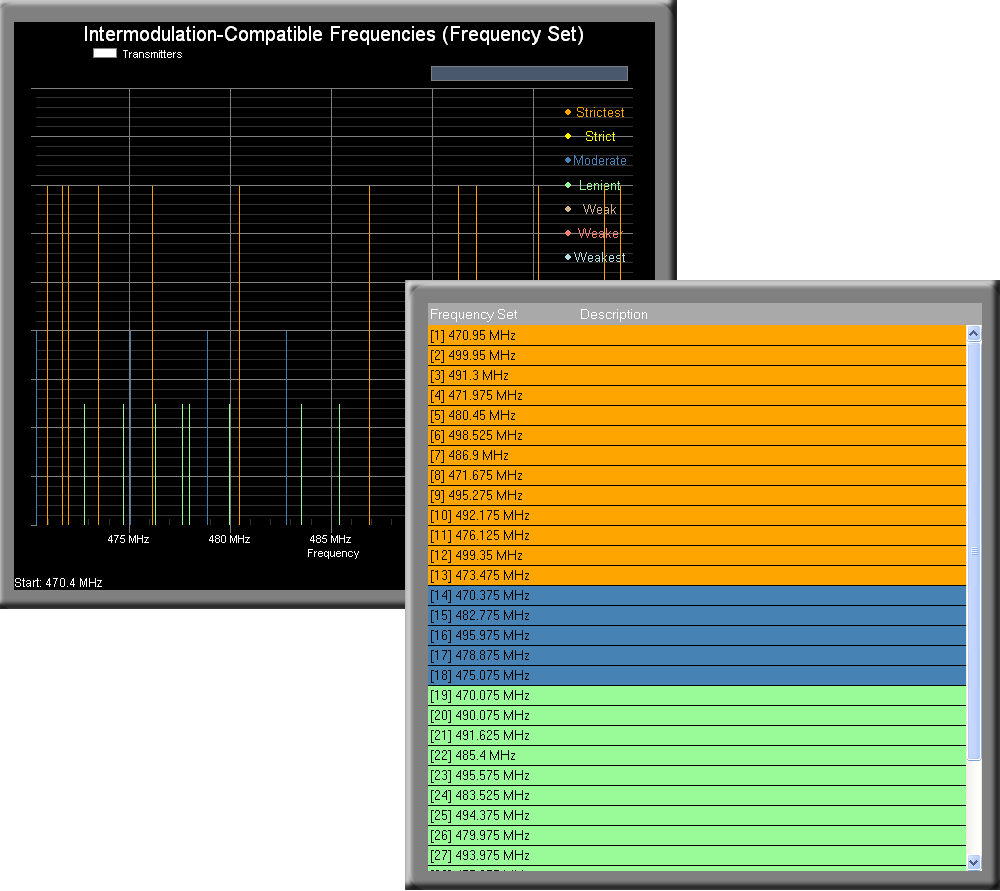Intermod Assist is the first to introduce Smart Frequency Sets™ -- a patent-pending method of prioritizing and ranking frequencies free of interference from intermodulation products. The value that a Smart Frequency Set™ offers compared to a generic frequency set is in the way it groups and prioritizes frequencies -- from "best" to "worst". Where "best" means most reliable or least susceptible to interference from intermodulation products, and "worst" means least reliable. When preparing for a live performance the setup typically includes a variety of wireless audio gear -- some more important than others. Employing a Smart Frequency Set™ you can assign the most reliable channels to the most important transmitters (e.g. lead vocals), and less reliable channels to less important transmitters (e.g. back-ground instruments).
Another advantage of the Smart Frequency Set™ compared to a generic frequency set is that in most situations you'll have a greater number of frequencies to work with and to assign to wireless audio gear, including frequencies ranked at the strictest level that can be assigned to your high priority wireless transmitters. For example, consider a frequency range of 470 MHz to 500 MHz. A generic frequency set generated under the strictest conditions will include approximately 18 frequencies. The corresponding Smart Frequency Set™ will include approximately 33 frequencies. So, not only does a Smart Frequency Set™ give you more channels to work with, it also includes some frequencies ranked at the strictest level that you can assign to your high priority wireless transmitters.
A generic frequency set is composed of frequencies from a single stringency level and there is no concept of grouping by stringency or ranking frequencies within the set. As a result, a generic frequency set will always need to wrestle with the trade-off between stringency and number of frequencies in the set. If you need more channels then you'll have to lower the stringency (and, hence, the reliability) of the set. Or, if you have need of greater reliability then you'll have to make do with fewer frequencies. On the other hand, a Smart Frequency Set™ includes the best of both worlds -- it maximizes the number of frequencies you get to work with and, at the same time, includes frequencies with the highest degree of stringency.
When working with wireless audio/video equipment one is typically concerned with 3 types of intermodulation products. These are the ones that happen to be closest to the fundamental frequencies. They are:
When creating an intermodulation-compatible frequency set any combination of these 3 tests can be applied in order to obtain the desired level of reliability. In fact, these three intermod tests can be combined in different ways in order to generate frequency sets with 7 different levels of stringency or compatibility:
Intermod Products That Are Tested When The Frequency Set Is Generated
Stringency |
2Tx 3rds |
3Tx 3rds |
2Tx 5ths |
Strictest |
YES |
YES |
YES |
Strict |
YES |
YES |
|
Moderate |
YES |
YES |
|
Lenient |
YES |
||
Weak |
YES |
YES |
|
Weaker |
YES |
||
Weakest |
YES |
What this means is that a frequency set created under 'Strictest' conditions is guaranteed to be free of intermodulation interference caused by 2Tx 3rd-, 3Tx 3rd- and 2Tx 5th-order intermodulation products. Similarly, a frequency set created under 'Strict' conditions is guaranteed to be free of intermodulation interference caused by 2Tx 3rd- and 3Tx 3rd-order intermodulation products. And so on... For practical purposes we will primarily be concerned with the first 4 levels of stringency -- Strictest, Strict, Moderate, and Lenient. These 4 stringencies share one thing in common -- they are all guaranteed to be free of interference from 2Tx 3rd-order intermod products, which are the most destructive.
The traditional, generic frequency set is composed of frequencies that match one of the above stringencies -- that is, all frequencies within the set are of the same stringency or compatibility level. Generic frequency sets are usually designed by applying Strictest, Strict, Moderate or Lenient criteria since these meet the minimal requirement of being free of intermodulation interference caused by 2Tx 3rd-order products (which cause the greatest distortion). Furthermore, when using a generic frequency set the frequencies are usually listed in ascending order and there is no further differentiation. However, it turns out that not all frequencies within a frequency set are equal -- some are more reliable than others. One advantage you gain by employing a Smart Frequency Set™ is the frequencies within the set are ranked according to reliability, which now gives you the ability to assign the more reliable frequencies to your higher priority wireless transmitters without sacrificing the number of frequencies within the set.
Furthermore, within a Smart Frequency Set™ the frequencies are grouped within 3 stringency levels -- Strictest, Moderate and Lenient. Frequencies in the strictest group are the most reliable and can be assigned to your highest priority wireless transmitters, while frequencies in the moderate and lenient groups can be assigned to your lesser priority transmitters. Even with different stringency groups and ranked frequencies within each group, all frequencies within the Smart Frequency Set™ maintain a minimal degree of intermod compatibility -- at the very least they are free of interference from 2Tx 3rd-order intermodulation products.
To summarize, a Smart Frequency Set™ offers the following advantages compared to a generic frequency set:

In the section entitled Generate Smart Frequency Set you will learn how to create a Smart Frequency Set™. Above is an example of a Smart Frequency Set™ generated for the frequency range 470 MHz to 500 MHz. The different colors are used to denote frequencies that belong to different stringency groups (orange for 'Strictest', blue for 'Moderate' and light green for 'Lenient'). Furthermore, within each group the frequencies are ranked according to reliability.